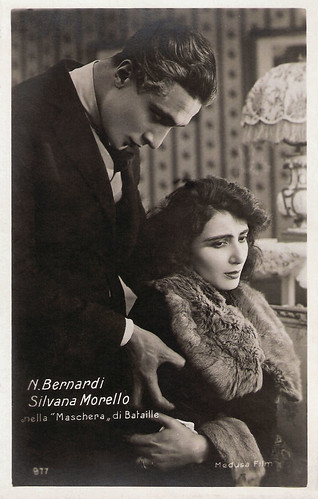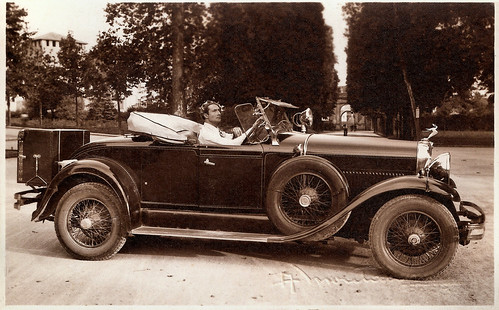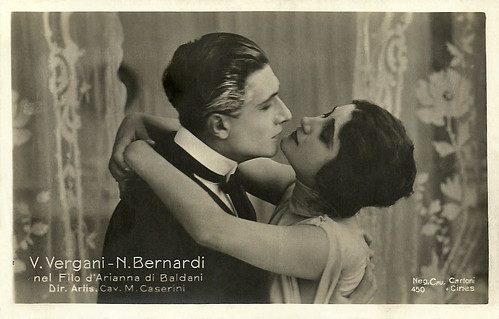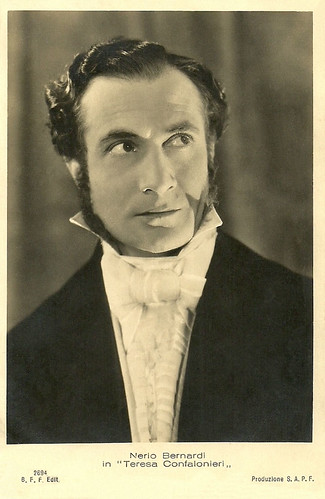Nerio Bernardi (1889–1971) was one of the dashing heroes and gentlemen in the melodramas and diva films of the silent Italian cinema. In his long career, the handsome stage and screen actor played in some 210 films.

Italian postcard by Neg. Vettori, Bologna, no. 404.

Italian postcard by G. Vettori, Bologna, no. 454. Photo: Renato Cartoni (who was also the cameraman). Vera Vergani and Nerio Bernardi in Il filo d'Arianna/Ariadne's thread (Mario Caserini, 1921).

Italian postcard by G. Vettori, Bologna, no. 977. Photo: Medusa Film. Nerio Bernardi and Silvana Morello in La maschera/The Mask (Ivo Illuminati, 1921), based on a play by Henry Bataille.
Nerio Bernardi was born in Bologna, Italy in 1889.
After having studied mathematics, medicine, counterpoint, and composition, he became an active stage and screen actor. Between 1918 and 1922 Bernardi was one of the dashing heroes and gentlemen in the Italian melodramas and diva films.
In 1918 his screen career started at the small company Felsina Film in his hometown Bologna, where he acted in Rebus (Mario Isma aka Alfredo Masi, 1918) and Marinella (Raimondo Scotti, 1918, released only in 1920). Both films were photographed by Raimondo Scotti whose photography was praised, while critics were less impressed with the rest.
After moving to Rome, Nerio Bernardi started to act with acclaimed actors and directors at the famous Cines company. In Bernardi's first Cines production, Il gorgo fascinatore/The Things Men Do (Mario Caserini, 1919), he played an aggressive lover who tries to rape Luisa (Bianca Stagno-Bellincioni) but accidentally dies. When Luisa begs another lover, Glauco (Alberto Capozzi), to remove the body, he is arrested for murder.
In 1920 various films followed. He played his first lead role in La buona figliola/The good daughter (Mario Caserini, 1920) with Vera Vergani. Other films were La casa in rovina/The house in ruins (Amleto Palermi, 1920) with Gustavo Salvini, La modella/The model (Mario Caserini, 1920), again with Vergani, Il mulino/The mill (Camilo De Riso, 1920), and Musica profana/Profane music (Mario Caserini, 1920) with Elena Lunda and again with Bernardi in the lead.
A peak year for Bernardi was 1921 in which he made seven films. These included three films with Vera Vergani: Caterina (Mario Caserini, 1921), Il filo d’Arianna/Ariadne's thread (Mario Caserini, 1921), and Fior d’amore/Flower of love (Mario Caserini, 1921).
That year, he also appeared in L’eredità di Caino/Cain's heritage (Giuseppe Maria Viti, 1921) with Elena Sangro and Gianna Terribili-Gonzales, Giovanna la pallida/Giovanna the pallid (Ivo Illuminati, 1921) with Silvana Morello, and La maschera/The mask (Ivo Illuminati, 1921).
1922 was Bernardi’s last year in the Italian silent cinema. His films included La vittima/The victim (Jacques Creusy, 1922) with Vergani, Bolshevismo!/Bolshevism (directed by and starring Daisy Sylvan, 1922), and Nero (J. Gordon Edwards, 1922), with Bernardi acting as the Apostle opposite Jacques Grétillat as Emperor Nero and Edy Darclea as Acte.
Edwards’ production for Fox, shot in Italy, was followed by another epic film by him, the biblical The Shepherd King (J. Gordon Edwards, 1923), in which many of the cast of Nero returned including Darclea and Bernardi, who played the male lead as (King) David.

Italian postcard. Photo: Alberto Montacchini, Parma. The car is an Isotta Fraschini.

Italian postcard by Cines, no. 450. Photo: Vera Vergani and Nerio Bernardi in Il filo d'Arianna/Ariadne's thread (Mario Caserini, 1921).

Italian postcard by G. Vettori, Bologna, no. 453. Photo: Renato Cartoni (who was also the cameraman). Vera Vergani and Nerio Bernardi in Il filo d'Arianna/Ariadne's thread (Mario Caserini, 1921).
Nerio Bernardi then shifted to the stage, debuting at the Teatro degli italiani, under the direction of Lucio D’Ambra.
In the following years, Bernardi acted all over Italy and a.o. under the direction of Max Reinhardt (The Merchant of Venice, 1935). He acted opposite the famous stage actresses of those years, such as Tatiana Pavlova, Andreina Rossi, and Alda Borelli.
In 1938 he founded a theatre company with Romano Calò and Olga Solbelli.
After the introduction of sound film, Bernardi took up acting in Italian film again with a part in Tempo Massimo/Maximum time (Mario Mattoli, 1934), starring Vittorio De Sica and Milly.
In the same year, Bernardi had the male lead in Teresa Confalonieri/Loyalty of Love (Guido Brignone, 1934), with Marta Abba in the title role. The patriotic film won the Coppa Mussolini for best film at the 1934 Venice film festival.
From the mid-1930s on, Bernardi had a steady career in Italian sound cinema. Between 1936 and 1943, he appeared in some 12 films in various genres: including the Science Fiction comedy Mille chilometri al minuto!/1Thousand kilometres per minute (Mario Mattoli, 1940), the literary melodrama Fedora (Camillo Mastrocinque, 1942), and the patriotic drama Antonio Meucci (Enrico Guazzoni, 1940), in which he played Graham Bell opposite the Italian inventor of the telephone, played by Luigi Pavese.
During the Second World War, he moved to Spain where he worked in several films and also dubbed films. Back in Italy, he continued his career as a voice actor, dubbing for Cedric Hardwicke (Rope), Basil Rathbone (The Mark of Zorro), George Sanders (Son of Fury), Donald Crisp (How Green Was My Valley), and Henry Travers (Shadow of a Doubt).
From 1952 he taught make-up and scenic behaviour at the Accademia d'arte drammatica Silvio D'Amico in Rome.

Italian postcard, no. 55.

Italian postcard by Neg. Vettori, Bologna, no. 342.
In the postwar Italian cinema, Nerio Bernardi co-starred with actresses who had peaked in the war years such as Vivi Gioi in La portatrice di pane/The bread delivery woman (1950) and Maria Mercader in Cuore/Heart (1948).
But he also worked with the new generation of actresses such as with Carla Del Poggio in Core ʼngrato/The Ungrateful Heart(1951), Cosetta Greco in Il Viale della speranza/The avenue of hope (1953), Alida Valli in La mano dello straniero/The Stranger's Hand (1953), based on Graham Greene’s The Stranger’s Hand, and with Silvana Pampanini in Bellezze in biciletta/Beauties on Bicycles (1951).
He also acted in various films with Totò such as Il medico dei pazzi/The doctor of the insane (Mario Mattoli, 1954), Siamo uomini o caporali/Are We Men or Corporals? (Camillo Mastrocinque, 1955), Totò all’inferno/Toto in Hell (Camillo Mastrocinque, 1955), and Totò contro Maciste/Toto vs. Maciste (Fernando Cerchio, 1962).
Bernardi also often incarnated mythological and historical characters, such as Agamemnon in Adamo e Eva/Adam and Eve (Mario Mattoli, 1949) starring Macario, and in the same role in La guerra di Troia/The Trojan War (Giorgio Ferroni, 1961) starring Steve Reeves. He also was Belisarius in Teodora, imperatrice di Bisanzio/Theodora, Slave Empress (Riccardo Freda, 1954) starring Gianna Maria Canale.
In the later 1950s and 1960s, Bernardi acted in many sword and sandal films by directors such as Giorgio Ferroni and in particular Luigi Capuano. He played for instance Cicero in Giulio Cesare, il conquistatore delle Gallie/Caesar the Conqueror (Tanio Boccia, 1962) starring Cameron Mitchell, and Cardinal Richelieu in Zorro e i tre moschettieri/Zorro and the Three Musketeers (Luigi Capuano, 1963), starring Gordon Scott.
He also performed in auteur films such as La lunga notte del ʼ43/It Happened in '43 (Florestano Vancini, 1960), playing the father of Gabriele Ferzetti’s character, and Vanina Vanini/The Betrayer (Roberto Rossellini, 1961) as Cardinal Savelli opposite Sandra Milo and Laurent Terzieff.
Bernardi acted in various French and Franco-Italian productions as well, such as Thérèse Raquin (Marcel Carné, 1953) starring Simone Signoret, Mam’zelle Nitouche (Yves Allégret, 1954) with Fernandel, the period pieces La chartreuse de Parme (1948) and Fanfan-la-Tulipe (1952), both directed by Christian-Jaque and starring Gérard Philipe, and Plein soleil/Purple Noon (René Clement, 1960) starring Alain Delon.
In the late 1960s, Bernardi acted in Spaghetti Westerns and comic book thrillers as well.
Nerio Bernardi died in 1971 in Rome, Italy. He was 71.

Italian postcard by Neg. Vettori, Bologna, no. 502.

Italian postcard by Ballerini & Fratini Editori, Firenze, no. 2694. Photo: Produzione SAPF. Nerio Bernardi in the period piece Teresa Confalonieri/Loyalty of Love (Guido Brignone, 1934), with Marta Abba in the title role. Content: in 1821 count Federico Confalonieri (Bernardi) was arrested on the ground of conspiracy against the Austrian regime and was condemned to death. With great efforts, his wife Teresa (Abba) obtains a pardon from the Austrian Emperor, so the death penalty was changed into lifetime imprisonment at the notorious Spielberg prison in Brno, where the count remained locked up until 1836.
Sources: Vittorio Martinelli (Il cinema muto italiano, 1918-1922), Wikipedia (Italian, German and English) and IMDb.
This post was last updated on 5 April 2021.

Italian postcard by Neg. Vettori, Bologna, no. 404.

Italian postcard by G. Vettori, Bologna, no. 454. Photo: Renato Cartoni (who was also the cameraman). Vera Vergani and Nerio Bernardi in Il filo d'Arianna/Ariadne's thread (Mario Caserini, 1921).

Italian postcard by G. Vettori, Bologna, no. 977. Photo: Medusa Film. Nerio Bernardi and Silvana Morello in La maschera/The Mask (Ivo Illuminati, 1921), based on a play by Henry Bataille.
An aggressive lover
Nerio Bernardi was born in Bologna, Italy in 1889.
After having studied mathematics, medicine, counterpoint, and composition, he became an active stage and screen actor. Between 1918 and 1922 Bernardi was one of the dashing heroes and gentlemen in the Italian melodramas and diva films.
In 1918 his screen career started at the small company Felsina Film in his hometown Bologna, where he acted in Rebus (Mario Isma aka Alfredo Masi, 1918) and Marinella (Raimondo Scotti, 1918, released only in 1920). Both films were photographed by Raimondo Scotti whose photography was praised, while critics were less impressed with the rest.
After moving to Rome, Nerio Bernardi started to act with acclaimed actors and directors at the famous Cines company. In Bernardi's first Cines production, Il gorgo fascinatore/The Things Men Do (Mario Caserini, 1919), he played an aggressive lover who tries to rape Luisa (Bianca Stagno-Bellincioni) but accidentally dies. When Luisa begs another lover, Glauco (Alberto Capozzi), to remove the body, he is arrested for murder.
In 1920 various films followed. He played his first lead role in La buona figliola/The good daughter (Mario Caserini, 1920) with Vera Vergani. Other films were La casa in rovina/The house in ruins (Amleto Palermi, 1920) with Gustavo Salvini, La modella/The model (Mario Caserini, 1920), again with Vergani, Il mulino/The mill (Camilo De Riso, 1920), and Musica profana/Profane music (Mario Caserini, 1920) with Elena Lunda and again with Bernardi in the lead.
A peak year for Bernardi was 1921 in which he made seven films. These included three films with Vera Vergani: Caterina (Mario Caserini, 1921), Il filo d’Arianna/Ariadne's thread (Mario Caserini, 1921), and Fior d’amore/Flower of love (Mario Caserini, 1921).
That year, he also appeared in L’eredità di Caino/Cain's heritage (Giuseppe Maria Viti, 1921) with Elena Sangro and Gianna Terribili-Gonzales, Giovanna la pallida/Giovanna the pallid (Ivo Illuminati, 1921) with Silvana Morello, and La maschera/The mask (Ivo Illuminati, 1921).
1922 was Bernardi’s last year in the Italian silent cinema. His films included La vittima/The victim (Jacques Creusy, 1922) with Vergani, Bolshevismo!/Bolshevism (directed by and starring Daisy Sylvan, 1922), and Nero (J. Gordon Edwards, 1922), with Bernardi acting as the Apostle opposite Jacques Grétillat as Emperor Nero and Edy Darclea as Acte.
Edwards’ production for Fox, shot in Italy, was followed by another epic film by him, the biblical The Shepherd King (J. Gordon Edwards, 1923), in which many of the cast of Nero returned including Darclea and Bernardi, who played the male lead as (King) David.

Italian postcard. Photo: Alberto Montacchini, Parma. The car is an Isotta Fraschini.

Italian postcard by Cines, no. 450. Photo: Vera Vergani and Nerio Bernardi in Il filo d'Arianna/Ariadne's thread (Mario Caserini, 1921).

Italian postcard by G. Vettori, Bologna, no. 453. Photo: Renato Cartoni (who was also the cameraman). Vera Vergani and Nerio Bernardi in Il filo d'Arianna/Ariadne's thread (Mario Caserini, 1921).
Coppa Mussolini
Nerio Bernardi then shifted to the stage, debuting at the Teatro degli italiani, under the direction of Lucio D’Ambra.
In the following years, Bernardi acted all over Italy and a.o. under the direction of Max Reinhardt (The Merchant of Venice, 1935). He acted opposite the famous stage actresses of those years, such as Tatiana Pavlova, Andreina Rossi, and Alda Borelli.
In 1938 he founded a theatre company with Romano Calò and Olga Solbelli.
After the introduction of sound film, Bernardi took up acting in Italian film again with a part in Tempo Massimo/Maximum time (Mario Mattoli, 1934), starring Vittorio De Sica and Milly.
In the same year, Bernardi had the male lead in Teresa Confalonieri/Loyalty of Love (Guido Brignone, 1934), with Marta Abba in the title role. The patriotic film won the Coppa Mussolini for best film at the 1934 Venice film festival.
From the mid-1930s on, Bernardi had a steady career in Italian sound cinema. Between 1936 and 1943, he appeared in some 12 films in various genres: including the Science Fiction comedy Mille chilometri al minuto!/1Thousand kilometres per minute (Mario Mattoli, 1940), the literary melodrama Fedora (Camillo Mastrocinque, 1942), and the patriotic drama Antonio Meucci (Enrico Guazzoni, 1940), in which he played Graham Bell opposite the Italian inventor of the telephone, played by Luigi Pavese.
During the Second World War, he moved to Spain where he worked in several films and also dubbed films. Back in Italy, he continued his career as a voice actor, dubbing for Cedric Hardwicke (Rope), Basil Rathbone (The Mark of Zorro), George Sanders (Son of Fury), Donald Crisp (How Green Was My Valley), and Henry Travers (Shadow of a Doubt).
From 1952 he taught make-up and scenic behaviour at the Accademia d'arte drammatica Silvio D'Amico in Rome.

Italian postcard, no. 55.

Italian postcard by Neg. Vettori, Bologna, no. 342.
Working with the new generation of actresses
In the postwar Italian cinema, Nerio Bernardi co-starred with actresses who had peaked in the war years such as Vivi Gioi in La portatrice di pane/The bread delivery woman (1950) and Maria Mercader in Cuore/Heart (1948).
But he also worked with the new generation of actresses such as with Carla Del Poggio in Core ʼngrato/The Ungrateful Heart(1951), Cosetta Greco in Il Viale della speranza/The avenue of hope (1953), Alida Valli in La mano dello straniero/The Stranger's Hand (1953), based on Graham Greene’s The Stranger’s Hand, and with Silvana Pampanini in Bellezze in biciletta/Beauties on Bicycles (1951).
He also acted in various films with Totò such as Il medico dei pazzi/The doctor of the insane (Mario Mattoli, 1954), Siamo uomini o caporali/Are We Men or Corporals? (Camillo Mastrocinque, 1955), Totò all’inferno/Toto in Hell (Camillo Mastrocinque, 1955), and Totò contro Maciste/Toto vs. Maciste (Fernando Cerchio, 1962).
Bernardi also often incarnated mythological and historical characters, such as Agamemnon in Adamo e Eva/Adam and Eve (Mario Mattoli, 1949) starring Macario, and in the same role in La guerra di Troia/The Trojan War (Giorgio Ferroni, 1961) starring Steve Reeves. He also was Belisarius in Teodora, imperatrice di Bisanzio/Theodora, Slave Empress (Riccardo Freda, 1954) starring Gianna Maria Canale.
In the later 1950s and 1960s, Bernardi acted in many sword and sandal films by directors such as Giorgio Ferroni and in particular Luigi Capuano. He played for instance Cicero in Giulio Cesare, il conquistatore delle Gallie/Caesar the Conqueror (Tanio Boccia, 1962) starring Cameron Mitchell, and Cardinal Richelieu in Zorro e i tre moschettieri/Zorro and the Three Musketeers (Luigi Capuano, 1963), starring Gordon Scott.
He also performed in auteur films such as La lunga notte del ʼ43/It Happened in '43 (Florestano Vancini, 1960), playing the father of Gabriele Ferzetti’s character, and Vanina Vanini/The Betrayer (Roberto Rossellini, 1961) as Cardinal Savelli opposite Sandra Milo and Laurent Terzieff.
Bernardi acted in various French and Franco-Italian productions as well, such as Thérèse Raquin (Marcel Carné, 1953) starring Simone Signoret, Mam’zelle Nitouche (Yves Allégret, 1954) with Fernandel, the period pieces La chartreuse de Parme (1948) and Fanfan-la-Tulipe (1952), both directed by Christian-Jaque and starring Gérard Philipe, and Plein soleil/Purple Noon (René Clement, 1960) starring Alain Delon.
In the late 1960s, Bernardi acted in Spaghetti Westerns and comic book thrillers as well.
Nerio Bernardi died in 1971 in Rome, Italy. He was 71.

Italian postcard by Neg. Vettori, Bologna, no. 502.

Italian postcard by Ballerini & Fratini Editori, Firenze, no. 2694. Photo: Produzione SAPF. Nerio Bernardi in the period piece Teresa Confalonieri/Loyalty of Love (Guido Brignone, 1934), with Marta Abba in the title role. Content: in 1821 count Federico Confalonieri (Bernardi) was arrested on the ground of conspiracy against the Austrian regime and was condemned to death. With great efforts, his wife Teresa (Abba) obtains a pardon from the Austrian Emperor, so the death penalty was changed into lifetime imprisonment at the notorious Spielberg prison in Brno, where the count remained locked up until 1836.
Sources: Vittorio Martinelli (Il cinema muto italiano, 1918-1922), Wikipedia (Italian, German and English) and IMDb.
This post was last updated on 5 April 2021.
No comments:
Post a Comment